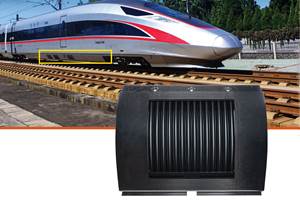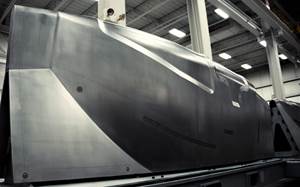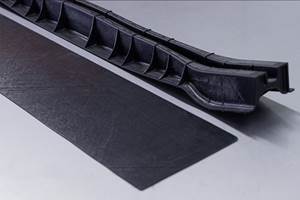Buckling of composite material compression specimens
Dr. Donald F. Adams (Wyoming Test Fixtures, Salt Lake City, Utah) rehearses the causes of, and solutions for, problems with buckling in composite compression specimens.
Because composite material test specimens tend to be relatively thin, buckling prior to the desired failure mode is a concern when specimens are loaded in compression. Known as column buckling, but also termed Euler buckling or gross buckling, this phenomenon is an instability. That is, the test specimen carries the applied load as it increases with no indication of incipient failure until it suddenly collapses when the load is increased by a small amount.
That is a problem because most composite materials tend to be brittle, so when they are loaded in compression, true compressive failure is likewise very sudden. It is impossible to determine if premature buckling or compressive failure has occurred simply by observing the test because each happens too quickly. Likewise, it is impossible to determine if buckling has occurred based on a postfailure visual examination of either the gross failure mode or the local fracture surface.1
Given that, the usual buckling detection method is to use back-to-back strain gages on the specimen when it is loaded. If the compressive modulus and/or the compressive stress-strain response to failure is to be determined as part of the test procedure, at least one strain gage must be used anyway. It is not, then, a major time or cost burden to add a second gage. However, if only strength is to be measured, the use of strain gages is a significant additional time and cost factor. But it is important to do so, because a specimen could buckle well before the ultimate compressive stress is reached. This is demonstrated in the two plots illustrated in the second image, at left.
Shown in the left plot are the stress-strain curves from the two gages for a 16-ply S-glass/epoxy unidirectional composite. The initial strain readings on both gages are almost identical. However, as the applied load is increased and the specimen starts to buckle, the two strain readings rapidly diverge, and the strain on the convex surface decreases (attempting to become a tensile strain) while the strain on the concave side rapidly increases. Note that for this particular specimen, the applied compressive stress at which buckling occurred was only 593 MPa/86 ksi. The plot on the right is for an identical S-glass/epoxy unidirectional composite that, at 32 plies, was twice as thick. This thicker specimen did not buckle, failing in compression at an applied stress of 1,104 MPa/160 ksi. This stress is almost twice as much as that attained for the thinner specimen that buckled. This clearly demonstrates why prevention of buckling is important.
The applied compressive stress at which buckling will occur can be estimated using the so-called Euler buckling equation, developed for isotropic materials but subsequently modified to account for the influence of material orthotropy. This modified equation to predict the buckling stress, σb, is
σb = π2Ex/[(Kℓ/r)2 + 1.2π2(Ex/Gxz)] (1)
where:
Ex = axial stiffness in the direction of compressive loading
Gxz = shear stiffness in the through-the-thickness direction (direction of buckling)
ℓ = specimen gage length (unsupported length)
K = end constraint factor (assuming pin-ends, K = 1)
r = radius of gyration of specimen cross section, r = (I/A)½
Note that the specimen, independent of its cross-sectional shape, is predicted to buckle around the cross-sectional axis for which r, and, thus, the moment of inertia (I), is the smallest, as would be expected because this is the axis at which the bending resistance is the lowest.
The second term in the denominator of the buckling equation was added to the classical Euler buckling equation to represent the influence of material orthotropy. This term is not negligible. For example, for a typical carbon/epoxy unidirectional composite it is almost equal to the first term in the denominator. In fact, under the influence of material orthotropy, the predicted buckling stress is reduced by almost 50 percent. To neglect orthotropy is to invite a falsely high prediction of buckling stress, which could lead to buckling problems. The goal, then, is to design a composite compression specimen for which the expected actual compressive strength is comfortably lower than the predicted buckling stress.
Assuming a typical specimen of rectangular cross-section, the buckling equation can be solved for specimen thickness, h, as given in ASTM D66412 and D34103. Equation 1 becomes
h ≥ ℓ/0.9069[(1-1.2σu/Gxz)(Ex/σu)]½ (2)
where σu is the estimated ultimate compressive stress. Note that h is present implicitly in equation 1 because, for a rectangular cross-section, the cross-sectional area (A) equals b times h (A = bh), where b is the specimen width. For specimens of rectangular cross-section, this form of the buckling equation can be used to estimate the required specimen thickness, based on the anticipated or estimated compressive strength.
Although the orthotropic buckling equation provides only an estimate, it has been shown to be relatively reliable. However, it is probably good practice to add an additional 10 to 20 percent to the estimated thickness as a safety factor.
Note that to use equations 1 and 2, the material properties Ex and Gxz of the test specimen must be input. The axial stiffness of the specimen, Ex, is usually known, or can be readily estimated. And although the interlaminar shear stiffness, Gxz, is not as commonly measured, it also can be estimated. For example, for a 0/90 (cross-ply) laminate, a procedure is recommended by Wegner and Adams4,
Gxz = 2/[(1/G12 + (1/G23)] (3)
where:
G12 = in-plane shear modulus of the plies
G23 = interlaminar shear modulus of the plies
Although the 32-ply specimen did not buckle, some bending occurred, indicated by the fact that the two strain gages did not track with each other as the load was applied. The influence of bending on the measured compressive strength will be addressed in my next column.
References:
1E.M. Odom and D.F. Adams, “Failure Modes of Unidirectional Carbon/Epoxy Composite Compression Specimens,” Composites, Vol. 21, No. 4, July 1990, pp. 289-296.
2ASTM Standard D6641, “Compressive Properties of Polymer Matrix Composite Materials Using a Combined Loading Compression (CLC) Test Fixture,” ASTM International (W. Conshohocken, Pa.).
3ASTM Standard D3410, “Compressive Properties of Polymer Matrix Composite Materials with Unsupported Gage Section by Shear Loading,” ASTM International (W. Conshohocken, Pa.).
4P.M. Wegner and D.F. Adams, “Verification of the Combined Load Compression (CLC) Test Method,” Report DOT/FAA/AR-00/26, Federal Aviation Admin. (Washington, D.C.), August 2000, p. 82.
Related Content
Composite sidewall cover expands options for fire-safe rail components
R&D project by CG Rail explores use of carbon fiber-reinforced thermoplastics and recycled manufacturing scrap to meet fire safety, weight and volume targets.
Read MoreNine factors to consider when designing composites cure tooling
Gary Bond discusses the common pitfalls and compromises when designing good cure tooling and their holistic significance for a robust composite production process.
Read MoreJeep all-composite roof receivers achieve steel performance at low mass
Ultrashort carbon fiber/PPA replaces steel on rooftop brackets to hold Jeep soft tops, hardtops.
Read MoreOptimized approach to predict delamination failure in CFRTP structures
ARRK Engineering and Mitsui Chemicals improved delamination prediction accuracy to help optimize absorbed energy/failure load for an overmolded TAFNEX CF/PP UD tape bumper beam.
Read MoreRead Next
Developing bonded composite repair for ships, offshore units
Bureau Veritas and industry partners issue guidelines and pave the way for certification via StrengthBond Offshore project.
Read MoreVIDEO: High-volume processing for fiberglass components
Cannon Ergos, a company specializing in high-ton presses and equipment for composites fabrication and plastics processing, displayed automotive and industrial components at CAMX 2024.
Read MoreAll-recycled, needle-punched nonwoven CFRP slashes carbon footprint of Formula 2 seat
Dallara and Tenowo collaborate to produce a race-ready Formula 2 seat using recycled carbon fiber, reducing CO2 emissions by 97.5% compared to virgin materials.
Read More




















